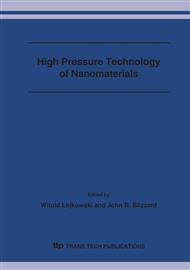[1]
H. J. McQueen, The production and utility of recovered dislocation substructures, Metal. Trans., 8A, No. 6, 807-824 (1977).
DOI: 10.1007/bf02661562
Google Scholar
[2]
M. L. Bernshtein, Structure of Deformed Crystals, [in Russian], Metallurgiya, Moscow (1977).
Google Scholar
[3]
V. I. Trefilov, Yu. V. Mil'man, and S. A. Firstov, Physical Fundamentals of the Strength of Refractory Metals [in Russian], Naukova Dumka, Kiev (1975).
Google Scholar
[4]
Yu. V. Mil'man, Structural aspects of warm and cold deformation of crystalline materials, Metalloved. Term. Obrab. Met., No. 6, 2-6 (1985).
Google Scholar
[5]
V. I. Trefilov, Yu. V. Milman, and I. V. Gridneva, Characteristic temperature of deformation of crystalline materials, Cryst. Res. Technol., 19, No. 3, 413-421 (1984).
DOI: 10.1002/crat.2170190321
Google Scholar
[6]
I. V. Gridneva, E. R. Dobrovinskaya, D. V. Lotsko, et al., Mobility of dislocations in a corundum single crystal, Izv. Akad. Nauk SSSR, Ser. Neorg. Mater., No. 10, 2134-2138 (1991).
Google Scholar
[7]
A. N. Vergazov, V. A. Likhachev, and V. V. Rybin, Examination of the fragmented structures formed in molybdenum in active plastic deformation, Fiz. Met. Metalloved., 42, No. 6, 1241-246 (1976).
Google Scholar
[8]
V. I. Trefilov, Yu. V. Mil'man, R. K. Ivashshenko, et al., Structure, Texture, and Mechanical Properties of Deformed Molybdenum Alloys [in Russian], Naukova Dumka, Kiev (1983).
Google Scholar
[9]
I. F. Kazo, I. V. Gridneva, Yu. V. Mil'man, and V. I. Trefilov, Effect of structural parameters on deformation and failure of covalent crystals, Metallofizika, 2, No. 5, 56-64 (1980).
Google Scholar
[10]
Yu. V. Mil'man, I. V. Gridneva, V. A. Goncharuk, et al., Effect of temperature on the failure mechanisms and mechanical properties of semiconductor compounds of the type AII B VI , Fiz. Khim. Obrab. Mater., No. 2, 128-133(1988).
Google Scholar
[11]
R. A. Andrievsky, On the temperature dependence of densification in sintering, Sci. Sinter., 16, No. 1, 3-6 (1984).
Google Scholar
[12]
V. I. Trefilov, Yu. V. Mil'man, and I. V. Gridneva, Mechanical properties of covalent crystals, Izv. Akad Nauk SSR, Ser. Neorg. Mater., 20, No. 6, 958-966 (1984).
Google Scholar
[13]
V. I. Trefilov and Yu. V. Mil'man, Physical nature of the temperature dependence of the yield limit, in: Fracture Mechanisms of Metals [in Russian], Naukova Dumka, Kiev (1966), pp.59-76.
Google Scholar
[14]
M. F. Ashby, A first report of deformation-mechanism maps, Acta Met., 20, No. 7, 887902 (1972).
Google Scholar
[15]
F. R. Nabarro, Deformation of crystals by die motion of single ions, in: Reports of a Conference on Strength of Solids (Bristol 7-9 July 1947), The Physical Soc. of London, Cambridge, (1948), pp.75-90.
Google Scholar
[16]
C. Hering, Diffusional viscosity of a polycrystalline solid, J. Appl. Phys, 21, No. 5, 437445 (1950).
Google Scholar
[17]
I. M. Lifshits, Theory of dynamic-viscose yielding of polycrystalline solids, Zh Eksp. Teor. Fiz., 44, 1349-1357 (1963).
Google Scholar
[18]
R. L. Coble, A model for boundary diffusion controlled creep in polycrystalline materials, J. Appl. Phys., 34, 1679 (1963).
Google Scholar
[19]
M. F. Ashby and R. A. Verrall, Diffusion-accommodated flow and superplasticity, Acta. Met., 21, No. 2, 149-158 (1973).
DOI: 10.1016/0001-6160(73)90057-6
Google Scholar
[20]
Ya. E. Geguzin, Physics of Sintering [in Russian], Nauka, Moscow (1984).
Google Scholar
[21]
Ya. E. Geguzin, A. S. Dzyuba, and V. P. Matsokin, Dislocation structures formed in the contact zone of two single crystals, Ukr. Fiz. Zh., 29, No. 9, 1419-1422 (1984).
Google Scholar
[22]
Ya. E. Geguzin, A. K. Emets, V. G. Kononenko, and D. V. Pluzhnikova, Dislocation mechanism of high-temperature deformation of elements of the roughness of compressed real surfaces, Poroshk. Metall., No. 6, 35-42 (1982).
DOI: 10.1007/bf00801754
Google Scholar
[23]
W. Schatt, Untersudningen an kupfer-einkristall sintermodellen, Kristall und Technik, 10, No. 9, 845-854 (1975).
DOI: 10.1002/crat.19750100808
Google Scholar
[24]
W. Schatt and E. Friedrich, Versetzungsbildung wahrend des sinterns, Planseeberichte fur Pulvermetallurgie, 23, No. 3, 145-156 (1977).
Google Scholar
[25]
S. Erdmann-Jesnitzer and F. Günther, Gesetzmässigkeiten bei verwachsungsvorgängen von kristallen. II. Ront-egenographische untersuchungen an verklebten steinsalzkristallen, Z. Metallkunde, 46, No. 12, 801-809 (1955).
DOI: 10.1515/ijmr-1955-461105
Google Scholar
[26]
Yu. I. Boiko and R. B. Lakhterman, Stresses formed in diffusion sintering sets of real powder particles, Poroshk. Metall., No. 8, 31-34 (1976).
Google Scholar
[27]
W. Schatt and E. Friedrich, Dislocation-activated sintering processes, in: Sintering-85, Plenum Press, New York, London, (1987), pp.133-141.
DOI: 10.1007/978-1-4613-2851-3_13
Google Scholar
[28]
Μ. Ρ. Poire, High-Temperature Plasticity of Crystalline Solids [Russian translation], Metallurgiya, Moscow (1982).
Google Scholar
[29]
F. Garofalo, Laws of Creep and Long-Term Strengths of Metals [Russian translation], Metallurgiya, Moscow (1968).
Google Scholar
[30]
I. Weertman, Steady-state creep of crystals, J. Appl. Phys., 28, No. 10, 1185-1189 (1957).
DOI: 10.1063/1.1722604
Google Scholar
[31]
G. C. Kuczynski, Study of sintering of glass, J. Appl. Phys., 20, 1160-1169 (1949).
Google Scholar
[32]
N. E. Exner, Principles of Single Phase Sintering, Frend Publ. House, Tel Aviv (1979).
Google Scholar
[33]
I. P. Arsentyeva and Μ. Μ. Ristic, Dislocation structure of nickel powder and its role in the sintering process, in: Sintering 85, Plenum Press, New York-London, (1987), p.5965.
DOI: 10.1007/978-1-4613-2851-3_6
Google Scholar
[34]
K. A. Christiansen and A. R. Tholen, Twin formation during sintering of micron and submicron sized copperparticles, in: Sintering 85, Plenum Press, New York-London, (1987), pp.69-79.
DOI: 10.1007/978-1-4613-2851-3_7
Google Scholar
[35]
I. P. Arsentyeva, M. M. Ristic, Dislocation structure of nickel powder and its role in the sintering process, in: Sintering 85, Plenum Press, New York-London, (1987), pp.59-65.
DOI: 10.1007/978-1-4613-2851-3_6
Google Scholar
[36]
M.M. Ristic, V.I. Trefilov, Yu.V. Milman et al. The structure and properties of sintered materials. Serbian academy of science and art. Monographs. Belgrad, 1992, Vol. DCXV, Iss. 35, 261p.
Google Scholar


